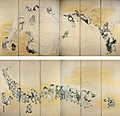Artist
Nagasawa Rosetsu
(長沢蘆雪; 1754–1799)
Catalogue information
Edo period
Pair of six-panel folding screens; ink and gold on paper
Each screen 168.7 x 360 cm (66 3/8 in. x 11 ft. 9 3/4 in.)
Donated to the Minneapolis Institute of Art by the Mary and Jackson Burke Foundation in 2015
Literature
Murase 1975, no. 62
; 1975
Japanese Art: Selections from the Mary and Jackson Burke Collection. Exh. cat. New York: The Metropolitan Museum of Art.
Avitabile 1990, no. 87
; 1990
[Editor]. Die Kunst des alten Japan: Meisterwerke aus der Mary and Jackson Burke Collection, New York. Exh. cat. Frankfurt: Schirn Kunsthalle Frankfurt.
Amino Yoshihiko et al. 1991, pp. 332–33
; 1991
[Editors]. Ten no hashi, chi no hashi (The heavenly bridge, the earthly bridge). Ima wa mukashi, mukashi wa ima (Present is past, past is present), 2. Tokyo: Fukuinkan Shoten.
Guth 1992, color pls. 9a, b
; 1992
Asobi: Play in the Arts of Japan. Exh. cat., Katonah Museum of Art, San Antonio Museum of Art, and Los Angeles County Museum of Art. Katonah, N.Y.: Katonah Museum of Art.
Murase 1992, pp. 254–55 (details).
1992
Il Giappone. Storia universale dell’arte: La civiltà dell’Oriente. Turin: UTET.
See also
- Japanese paintings » Maruyama-Shijō School
- Screens
- Works of the Edo period
- Works by Nagasawa Rosetsu
This artwork was published as catalogue entry 397 in Volume I of Art through a Lifetime.
Additional details


Signature
[on left screen] Rosetsu painted the spirit
Seals
[on left screen] Kun
; Gyo



